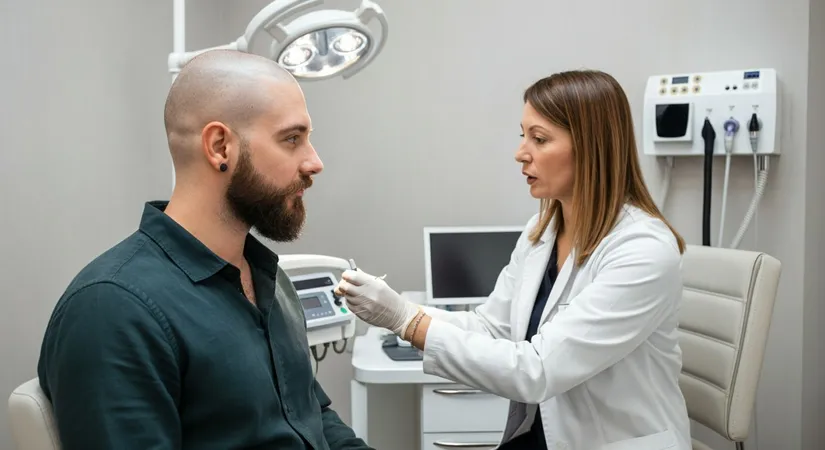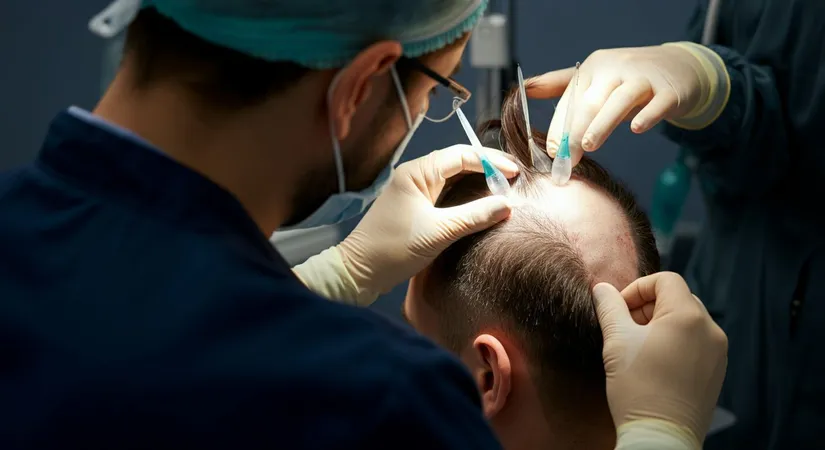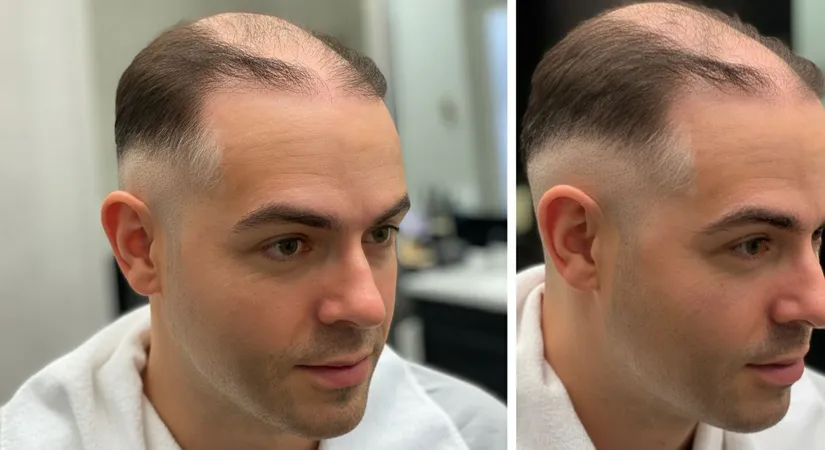Unlocking the Secrets of Hair Transplantation: Your Ultimate Guide
Master hair transplantation with expert insights, tips for recovery, and the latest techniques for restoring natural hair beauty.
Hair transplantation is a popular solution for those seeking to address hair loss and restore fuller, natural-looking hair. From understanding how the procedures work to the best techniques available today, this guide aims to provide detailed information on every aspect of the hair transplantation journey. We'll explore recovery timelines, debunk myths about permanence, and introduce innovative methods that promise remarkable results.
Understanding How Hair Transplantation Works
Key Techniques in Hair Transplantation
Hair transplantation is a sophisticated procedure that involves transferring hair follicles from a donor site, usually the back of the scalp, to areas experiencing hair loss. This method is highly effective due to the genetic resistance of the donor hair to balding. Two primary techniques dominate the field: Follicular Unit Extraction (FUE) and Direct Hair Implantation (DHI).
- FUE involves extracting individual hair follicles and implanting them into the recipient area, minimizing visible scarring.
- DHI uses a specialized tool to implant hair directly, offering precise placement and natural growth patterns.
- Both techniques ensure minimal downtime and natural-looking results, tailored to individual scalp conditions.
These methods are chosen based on the patient's specific needs, scalp condition, and desired outcomes. For instance, FUE might be preferred for those seeking less invasive options, while DHI could be ideal for precise hairline restoration.
Steps in the Hair Transplantation Process
- Consultation: Assessing scalp health and determining the best technique for the patient.
- Extraction: Carefully removing hair follicles from the donor site using FUE or DHI methods.
- Implantation: Placing the extracted follicles into the balding areas to achieve a natural appearance.
The process begins with a thorough consultation to evaluate the patient's hair loss pattern and scalp condition. Following this, the extraction phase involves meticulous removal of hair follicles, ensuring minimal damage and optimal survival rates. Finally, the implantation phase focuses on strategic placement to mimic natural hair growth, enhancing the overall aesthetic outcome.

Exploring the Best Hair Transplantation Techniques
Innovative Hair Transplantation Methods
Modern hair transplantation techniques have evolved significantly, offering patients advanced solutions with minimal discomfort. One such method is the Multi-Implanter technique, which is exclusive to estethica. This approach allows for precise follicle placement, resulting in denser and more natural-looking hair restoration.
- The Multi-Implanter technique ensures accurate follicle placement, enhancing hair density.
- Advanced technology minimizes discomfort and reduces recovery time.
- Results in a natural appearance, closely mimicking natural hair growth patterns.
These innovative techniques are designed to cater to individual needs, ensuring that each patient receives a tailored approach. For instance, the Multi-Implanter technique is particularly beneficial for those seeking a natural look with minimal downtime. This method not only improves the aesthetic outcome but also enhances the overall patient experience.
Steps to Achieve Optimal Hair Restoration
- Initial Assessment: Evaluating the patient's scalp condition and hair loss pattern.
- Technique Selection: Choosing the most suitable method, such as the Multi-Implanter, based on individual needs.
- Post-Procedure Care: Implementing a recovery plan to ensure optimal results and minimal downtime.
The process begins with a comprehensive assessment to understand the patient's unique requirements. Following this, the most appropriate technique is selected to achieve the desired outcome. Finally, a tailored post-procedure care plan is essential to maximize the benefits of the transplantation, ensuring a smooth recovery and long-lasting results.

Navigating Hair Transplant Recovery Time
Understanding the Recovery Phases
Hair transplant recovery involves several distinct phases, each crucial for achieving optimal results. Initially, patients may experience scalp tenderness and minor swelling, which typically subsides within a week. This is followed by a period where the transplanted hair sheds, making way for new growth.
- Initial tenderness and swelling are common but temporary.
- Shedding of transplanted hair occurs before new growth begins.
- New hair growth becomes visible within three to four months.
Understanding these phases helps patients manage expectations and adhere to post-operative care instructions. For instance, using specialized products like estethica's gold cream can enhance recovery by soothing the scalp and promoting healthy hair growth.
Effective Post-Operative Care Strategies
- Follow a gentle hair care routine to avoid irritation.
- Use recommended products to support scalp health and hair growth.
- Attend follow-up appointments to monitor progress and address concerns.
Implementing these strategies ensures a smoother recovery and maximizes the success of the hair transplantation. For example, a gentle hair care routine prevents irritation, while follow-up appointments allow for timely adjustments to the recovery plan. By adhering to these guidelines, patients can achieve the best possible outcomes from their hair restoration journey.

Debunking Myths: Is Hair Transplantation Permanent?
Factors Influencing Hair Transplant Longevity
While hair transplantation offers a long-term solution, several factors can influence its permanence. The genetic predisposition of the donor hair plays a crucial role, as these follicles are typically resistant to balding. However, underlying conditions such as hormonal imbalances or scalp health issues may impact future hair growth.
- Genetic resistance of donor hair ensures longevity.
- Hormonal changes can affect transplanted hair over time.
- Scalp health is vital for maintaining transplanted hair.
For instance, individuals with androgenetic alopecia may experience further hair thinning, necessitating additional treatments. Maintaining scalp health through proper care and follow-up treatments can enhance the results of hair transplantation, ensuring a more permanent outcome.
Enhancing Hair Transplant Results
- Regular follow-up appointments to monitor hair growth.
- Adopting a healthy lifestyle to support hair health.
- Utilizing advanced treatments like scalp micropigmentation.
Regular follow-ups with a specialist can help track progress and address any emerging issues. Additionally, a balanced diet and stress management can positively influence hair health. Advanced treatments, such as scalp micropigmentation, can complement hair transplantation by enhancing the appearance of density and fullness.
The Future of Hair Transplantation
Emerging Technologies in Hair Restoration
The field of hair transplantation is rapidly evolving with the introduction of cutting-edge technologies. One such advancement is the Safir FUE method, which utilizes sapphire blades for precise incisions, promoting faster healing and reducing scarring. This technique is gaining popularity due to its ability to create a more natural hairline and improve overall patient satisfaction.
- Safir FUE offers enhanced precision with sapphire blades.
- Reduces recovery time and minimizes visible scarring.
- Improves the natural appearance of transplanted hair.
These innovations are transforming the landscape of hair restoration, making it more accessible and effective for a wider range of patients. For example, the use of robotic assistance in hair transplantation is another promising development, allowing for greater accuracy and efficiency during the procedure.
Future Trends in Hair Transplantation
- Integration of AI for personalized treatment plans.
- Development of non-invasive hair restoration techniques.
- Advancements in genetic research to enhance hair growth.
As technology continues to advance, the future of hair transplantation looks promising. The integration of artificial intelligence (AI) is expected to revolutionize the field by providing personalized treatment plans based on individual genetic profiles. Additionally, ongoing research into non-invasive techniques and genetic therapies holds the potential to further enhance hair restoration outcomes, offering hope to those experiencing hair loss.
Choosing the Right Clinic for Your Hair Transplant
Evaluating Clinic Reputation and Expertise
When selecting a clinic for hair transplantation, it's crucial to consider the clinic's reputation and the expertise of its professionals. A well-regarded clinic often indicates a history of successful procedures and satisfied patients. For instance, clinics like estethica are known for their commitment to patient safety and satisfaction, offering tailored treatment plans that cater to individual needs.
- Research the clinic's history and patient reviews to gauge reputation.
- Verify the qualifications and experience of the medical team.
- Look for clinics that prioritize personalized care and advanced techniques.
These factors are essential in ensuring a positive experience and optimal results. For example, a clinic with a team of experienced surgeons and state-of-the-art technology can significantly enhance the success of hair transplantation procedures.
Assessing Technological Advancements and Facilities
- Examine the clinic's use of cutting-edge technology in hair restoration.
- Evaluate the quality and cleanliness of the clinic's facilities.
- Consider the availability of post-operative care and support services.
Advanced technology plays a pivotal role in achieving natural-looking results and minimizing recovery time. Clinics equipped with the latest tools and techniques, such as follicular unit extraction and scalp micropigmentation, can offer superior outcomes. Additionally, a well-maintained facility ensures a safe and comfortable environment for patients, further contributing to the overall success of the hair transplant journey.
Innovative Hair Transplantation Techniques with Multi-Implanter Method
Excellence in Hair Transplantation: From Consultation to Recovery
Frequently Asked Questions
What are the main techniques used in hair transplantation?
How does the recovery process work after a hair transplant?
Is hair transplantation a permanent solution for hair loss?
What innovative techniques are available in modern hair restoration?
How can I choose the right clinic for my hair transplant?
Discover the path to 'Healthy Beauty' with estethica's expert care. Call now for your free consultation and take the first step towards a more confident you!
📞 Call for Your Free Consultation